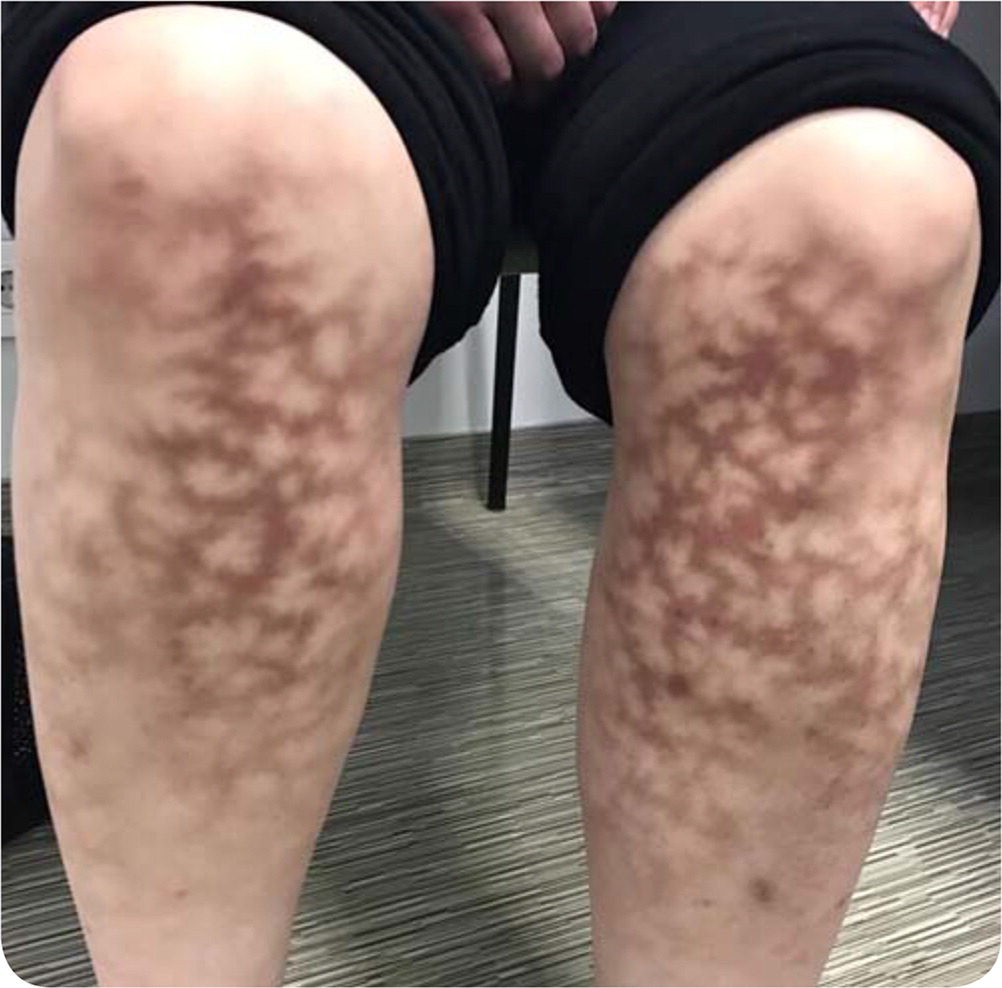
Symmetrical Reticulated Lower Extremity Rash
Am Fam Physician. 2019;100(1):51-52
Author disclosure: No relevant financial affiliations.
A healthy 30-year-old woman presented with a rash over both lower extremities (Figure 1) that began two months earlier. The rash was slightly itchy but not painful. She lived in a cold area and reported sitting in front of an electric heater for two to three hours daily over the previous two months.
On physical examination, the skin looked mottled, blotchy, and reticulated. It had a nonblanching network pattern and a blue-gray discoloration.

Question
Discussion
The answer is C: erythema ab igne. Erythema ab igne, also known as toasted skin syndrome, is a rare condition that results from prolonged and repeated exposure to thermal radiation. The heat exposure, usually between 109°F and 117°F (43°C to 47°C), is not intense enough to burn the skin but can result in skin involvement in a pattern that mirrors the heat source. Commonly affected areas include the anterior calves (fires), anterior thighs (laptops), and back or peripheral joints (heating pads or bottles). Less common sites include the face and the arms or palms of cooks. Abdominal and pelvic involvement has been reported in patients with visceral malignancies, peptic ulcer disease, or chronic pancreatitis, usually due to water bottles held against the abdomen or pelvis to reduce pain.
The affected area has a mottled, net-like, nonblanching pattern of blue-gray discoloration, sometimes with associated erythema and scale. Erythema ab igne is usually asymptomatic, but some patients have a burning sensation or pruritus in the affected area. Erythema ab igne is treated mainly by removing the heat source. Discoloration usually resolves over months to years; however, permanent scarring and hyperpigmentation can occur.1
Cutaneous lupus erythematosus lesions are scaly, superficial, erythematous macules, patches, and plaques that classically appear in a symmetrical distribution on sun-exposed areas, mainly on the upper body.2
In discoid lupus erythematosus, a subtype of chronic cutaneous lupus erythematosus, the lesions are fixed, well-demarcated, scaly, erythematous macules or papules that gradually develop into indurated discoid (coin-shaped) plaques with an adherent scale that is painful to remove. Lesions are often distributed on the head and neck, particularly over the scalp and ears. Pigment changes occur over time resulting in hyperpigmentation, hypopigmentation, and extensive scarring.3
Erythrocyanosis is a dusky cyanotic discoloration that occurs over areas with a thick layer of subcutaneous fat, such as the thighs and lower legs. It is exacerbated by cold temperatures. Erythrocyanosis is more common in adolescent girls and middle-aged women. The disorder may persist indefinitely with long-standing edema and fibrosis. Spontaneous improvement can occur in adolescent patients.4
Livedo reticularis is a condition caused by dilation of capillary blood vessels and stagnation of blood within these vessels. This results in a symmetrical, reticular, red-purple mottling that surrounds a pale central area. This discoloration becomes more pronounced with cold exposure and may completely dissipate with warming. The rash is more pronounced on the lower extremities, but the abdomen and upper extremities can be affected.5

| Condition | Characteristics | Location |
|---|---|---|
| Cutaneous lupus erythematosus | Scaly, superficial, erythematous macules, patches, and plaques | Sun-exposed areas |
| Discoid lupus erythematosus | Fixed, well-demarcated, scaly, erythematous macules or papules; gradually develop into indurated discoid (coin-like) plaques | Mostly over head and neck |
| Erythema ab igne | Mottled, net-like, nonblanching pattern of blue-gray discoloration, sometimes with associated erythema and scale | Areas exposed to nonburning thermal radiation |
| Erythrocyanosis | Dusky cyanotic discoloration, more common in adolescent girls and middle-aged women, exacerbated by cold temperatures | Areas with a thick layer of subcutaneous fat, such as the lower legs and thighs |
| Livedo reticularis | Symmetrical, reticular, red-purple mottling that surrounds a pale central area; worsens with cold exposure | Lower extremities |

